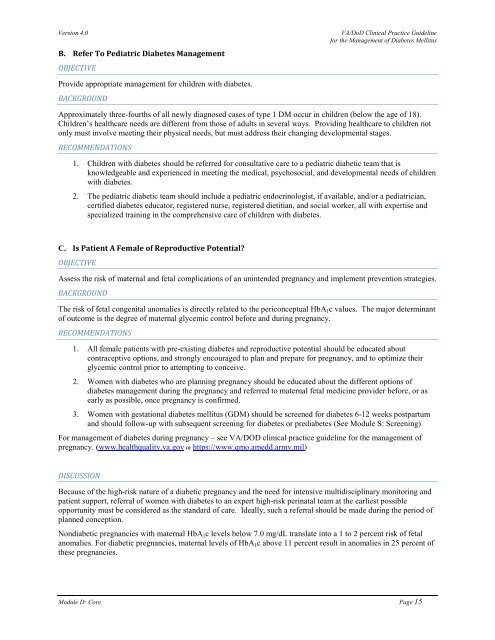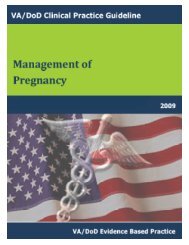DM Full Guideline (2010) - VA/DoD Clinical Practice Guidelines Home
DM Full Guideline (2010) - VA/DoD Clinical Practice Guidelines Home
DM Full Guideline (2010) - VA/DoD Clinical Practice Guidelines Home
You also want an ePaper? Increase the reach of your titles
YUMPU automatically turns print PDFs into web optimized ePapers that Google loves.
Version 4.0<br />
B. Refer To Pediatric Diabetes Management<br />
OBJECTIVE<br />
<strong>VA</strong>/<strong>DoD</strong> <strong>Clinical</strong> <strong>Practice</strong> <strong>Guideline</strong><br />
for the Management of Diabetes Mellitus<br />
Provide appropriate management for children with diabetes.<br />
BACKGROUND<br />
Approximately three-fourths of all newly diagnosed cases of type 1 <strong>DM</strong> occur in children (below the age of 18).<br />
Children’s healthcare needs are different from those of adults in several ways. Providing healthcare to children not<br />
only must involve meeting their physical needs, but must address their changing developmental stages.<br />
RECOMMENDATIONS<br />
1. Children with diabetes should be referred for consultative care to a pediatric diabetic team that is<br />
knowledgeable and experienced in meeting the medical, psychosocial, and developmental needs of children<br />
with diabetes.<br />
2. The pediatric diabetic team should include a pediatric endocrinologist, if available, and/or a pediatrician,<br />
certified diabetes educator, registered nurse, registered dietitian, and social worker, all with expertise and<br />
specialized training in the comprehensive care of children with diabetes.<br />
C. Is Patient A Female of Reproductive Potential?<br />
OBJECTIVE<br />
Assess the risk of maternal and fetal complications of an unintended pregnancy and implement prevention strategies.<br />
BACKGROUND<br />
The risk of fetal congenital anomalies is directly related to the periconceptual HbA 1 c values. The major determinant<br />
of outcome is the degree of maternal glycemic control before and during pregnancy.<br />
RECOMMENDATIONS<br />
1. All female patients with pre-existing diabetes and reproductive potential should be educated about<br />
contraceptive options, and strongly encouraged to plan and prepare for pregnancy, and to optimize their<br />
glycemic control prior to attempting to conceive.<br />
2. Women with diabetes who are planning pregnancy should be educated about the different options of<br />
diabetes management during the pregnancy and referred to maternal fetal medicine provider before, or as<br />
early as possible, once pregnancy is confirmed.<br />
3. Women with gestational diabetes mellitus (G<strong>DM</strong>) should be screened for diabetes 6-12 weeks postpartum<br />
and should follow-up with subsequent screening for diabetes or prediabetes (See Module S: Screening)<br />
For management of diabetes during pregnancy – see <strong>VA</strong>/DOD clinical practice guideline for the management of<br />
pregnancy. (www.healthquality.va.gov or https://www.qmo.amedd.army.mil)<br />
DISCUSSION<br />
Because of the high-risk nature of a diabetic pregnancy and the need for intensive multidisciplinary monitoring and<br />
patient support, referral of women with diabetes to an expert high-risk perinatal team at the earliest possible<br />
opportunity must be considered as the standard of care. Ideally, such a referral should be made during the period of<br />
planned conception.<br />
Nondiabetic pregnancies with maternal HbA 1 c levels below 7.0 mg/dL translate into a 1 to 2 percent risk of fetal<br />
anomalies. For diabetic pregnancies, maternal levels of HbA 1 c above 11 percent result in anomalies in 25 percent of<br />
these pregnancies.<br />
Module D: Core Page 15
















